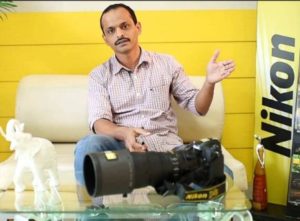Mumbai based Nayan Khanolkar got the one shot that would go on to win him the prestigious Wildlife Photographer Award, 2016 by the BBC and Natural History Museum in London.
About the Award :
The Wildlife Photographer of the Year competition provides a showcase for the world’s very best nature photography. The competition is owned by the world-renowned and trusted British institution, the Natural History Museum.
- Wildlife Photographer of the Year presents an attractive proposition for corporate partners that share the Museum’s principles and values.
- The Wildlife Photographer of the Year series consists of a major exhibition at the Museum and a worldwide tour. The winning images appear on this website and leading publications worldwide.

- Nayan was awarded the ‘Urban Wildlife category’ award in London. His picture shows a leopard staring directly into the lens as it walks underneath a tiny yellow bulb between two mud-splattered homes of tribals in Aarey Colony. This was the 52nd installment of the award, in which Khanolkar won from 50,000 entries across 90 countries.
- With his infrared cameras, he would place them at a strategic points, ensuring the camera settings were best to capture the light, and hoping that the leopard would pass in front of it.
- Khanolkar lives with his wife and parents in Dombivli. Every day, he would travel to Goregaon to check his cameras.
- He also works as a research fellow with Bombay Natural History Society along with working on clicking pictures of big cats to create awareness on preserving them.
About Wildlife Photography :
Wildlife photography is a genre of photography concerned with documenting various forms of wildlife in their natural habitat. It is one of the more challenging forms of photography.
- As well as requiring sound technical skills, such as being able to expose correctly, wildlife photographers generally need good field craft skills. For example, some animals are difficult to approach and thus a knowledge of the animal’s behavior is needed in order to be able to predict its actions. Photographing some species may requirestalking skills or the use of a hide/blind for concealment.
- While wildlife photographs can be taken using basic equipment, successful photography of some types of wildlife requires specialist equipment, such as macro lenses for insects, long focal length lenses for birds and underwater cameras for marine life. However, a great wildlife photograph can also be the result of being in the right place at the right time.
- The world’s three largest photography organisations, the Photographic Society of America, the Fédération Internationale de l’Art Photographique and the Royal Photographic Society have adopted a common definition for nature and wildlife photography to govern photography competitions, their respective presidents writing in a joint statement,
- “The development of a common definition for nature and wildlife photography will be an important step in helping photographers, many of whom enter competitions internationally, know what the rules are. It will also provide organisers with a very clear definition when they need to deal with the problem of ineligible images.”
AffairsCloud Recommends Oliveboard Mock Test
AffairsCloud Ebook - Support Us to Grow
Govt Jobs by Category
Bank Jobs Notification





